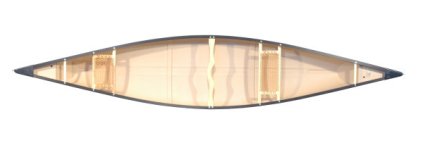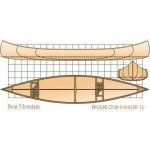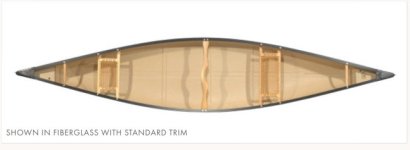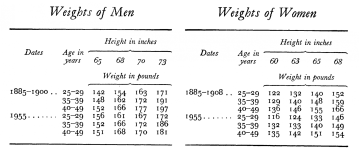My new Prospector 15 is still a month away. Probably too late for my first trip of the season. I had a Prospector 16 in Royalex, but only tripped with my wife along, and only in Sylvania, which is small. Anyone have some pointers about soloing in a loaded boat like this? I know it will be more apt to catch wind on big lakes. Should I take a double blade paddle? Is lining this canoe more tricky than a straight keel boat? What is the handling in a tailwind likely to be like? Any advice will be appreciated.
-
Happy National Audubon Day! 🐣🐦🦅🕊️
You are using an out of date browser. It may not display this or other websites correctly.
You should upgrade or use an alternative browser.
You should upgrade or use an alternative browser.
Backwards Prospector Expectations
- Thread starter Black_Fly
- Start date
Difficult to say without knowing how the load will be distributed and how heavy... it might help at first to adjust trim forward vs rearward by filling large plastic water jugs and adding them at the front as far as possible to see the difference in glide and reaction to strokes as trim is adjusted fore and aft. When the canoe becomes too forward-heavy it will not track straight well, always wanting to veer off to the right or left, you already know this, still, just how sensitive the new canoe will be to trim change is worth checking out.
Some will like the canoe trimmed level for more responsive control, others, slightly rear-heavy for more straightforward tracking.
Paddling into the wind, shift loads forward so that the canoe sits more deeply in the water forward and tends to weathercock into the wind, the reverse for following wind.
Prospectors will vary with manufacturers with some having fuller ends than others... the fuller-ended ones will be less sensitive to trim change since either end will submerge or lift out of the water less deeply because of greater volume and flotation. Play around with trim to find what works best for you..
If you are kneeling with a single blade and the canoe heeled over to one side, that changes hull shape underwater and response from paddling level with a double and sitting. Myself, one of the great pleasures is paddling kneeling off to one side for control strokes, so I'm biased and others will prefer something else... anyway, hope you find your canoe a good fit, cheers.
Some will like the canoe trimmed level for more responsive control, others, slightly rear-heavy for more straightforward tracking.
Paddling into the wind, shift loads forward so that the canoe sits more deeply in the water forward and tends to weathercock into the wind, the reverse for following wind.
Prospectors will vary with manufacturers with some having fuller ends than others... the fuller-ended ones will be less sensitive to trim change since either end will submerge or lift out of the water less deeply because of greater volume and flotation. Play around with trim to find what works best for you..
If you are kneeling with a single blade and the canoe heeled over to one side, that changes hull shape underwater and response from paddling level with a double and sitting. Myself, one of the great pleasures is paddling kneeling off to one side for control strokes, so I'm biased and others will prefer something else... anyway, hope you find your canoe a good fit, cheers.
G
Guest
Guest
My new Prospector 15 is still a month away. Probably too late for my first trip of the season. I had a Prospector 16 in Royalex, but only tripped with my wife along, and only in Sylvania, which is small. Anyone have some pointers about soloing in a loaded boat like this? I know it will be more apt to catch wind on big lakes. Should I take a double blade paddle? Is lining this canoe more tricky than a straight keel boat? What is the handling in a tailwind likely to be like?
Everything Frozentripper mentioned is of course true, and apparent to any tripper who has paddled at least a few different canoe designs. A “Prospector” is not some mythical beast to be tamed, it’s just (or should be) a deep, decently rockered canoe designed to haul a load, and you are one step ahead of some folks; you have already owned a Prospector canoe, and must be familiar with some of the handling characteristics of that design.
I suggest the following real-world sequence:
1.Get the canoe.
2.Paddle the canoe
2A. Maybe test paddle the canoe with a gear load first, just to see.
I am not you, nor is anyone else. How you prefer to pack, and paddle, maneuver/turn and handle winds is your own preference, borne of your own experience.
I’m not a fan of Prospectors for open lake travel, but I think everyone should take a double blade paddle J
I paddle a 16’ prospector almost exclusively when I’m with my dog. One of them is on my truck right now. They are slow and inefficient in lake country but super stable and dry. I think they shine on moving water. I also use a bell Northstar with the dog when lakes are the rule.
while I suspect the 15’ paddles different than a 16’, as someone who kayaks big bulbous creek boats and white water kayaks, I think you’d need a really long kayak paddle to overcome a wide and deep hull.
Enjoy the new prospector.
Barry
while I suspect the 15’ paddles different than a 16’, as someone who kayaks big bulbous creek boats and white water kayaks, I think you’d need a really long kayak paddle to overcome a wide and deep hull.
Enjoy the new prospector.
Barry
if you are using a double blade paddle from the stern seat as in the CT header you can use a very short double blade.
You probably will not be sitting on the center thwart so the width there has nothing to do with paddle length
Backwards from the bow seat I would hazard to guess would be similar to paddling a narrow dedicated solo with a double blade. Find ( borrow) a 240.
You probably will not be sitting on the center thwart so the width there has nothing to do with paddle length
Backwards from the bow seat I would hazard to guess would be similar to paddling a narrow dedicated solo with a double blade. Find ( borrow) a 240.
I have 240s, 260s. Will try both.
I'm curious, but paddling solo from the stern seat is something you can't really try without an actual tripping load. I could try three water jugs and the dog, maybe.
I'm curious, but paddling solo from the stern seat is something you can't really try without an actual tripping load. I could try three water jugs and the dog, maybe.
Jim Baird uses a double blade paddling his Novacraft Prospector 15, although here, on the first test paddle after buying in 2019 he's using a single. Since he weighs in at a respectable 270 pounds, the front of the canoe is riding high up and needs some load to bring it down. If it were a rough and windy day, the deeply-submerged rear could be at risk of swamping if water started coming in over the side while in a wave trough. But it's only a first test-paddle, not a fully loaded trip.
https://www.youtube.com/watch?v=Ojp2dHv3-iQ
On an actual trip in Algonquin carrying a load, the trim's much better, and the paddling's done with a double blade. There's a quick look showing this at the 38:15 mark if you don't want to see the entire vid... some nice brook trout being caught in parts one and two. Spring peepers going, too.
https://www.youtube.com/watch?v=0qubvKVBohE
Black Fly, Swift has load capacity numbers for their Prospector 15 although it might not be identical to yours... 300-550 pounds... Jim Baird's solo load - paddler, canoe and gear should fall somewhere in the middle. Enjoy the early-season paddling, Happy Easter.
https://www.youtube.com/watch?v=Ojp2dHv3-iQ
On an actual trip in Algonquin carrying a load, the trim's much better, and the paddling's done with a double blade. There's a quick look showing this at the 38:15 mark if you don't want to see the entire vid... some nice brook trout being caught in parts one and two. Spring peepers going, too.
https://www.youtube.com/watch?v=0qubvKVBohE
Black Fly, Swift has load capacity numbers for their Prospector 15 although it might not be identical to yours... 300-550 pounds... Jim Baird's solo load - paddler, canoe and gear should fall somewhere in the middle. Enjoy the early-season paddling, Happy Easter.
Last edited:
I had to paddle the NC 16 foot prospector solo for five days. We had to evacuate a kid, and it was the only option left. With a dedicated solo, I have no problem keeping up with the pack, or even being ahead of it, and that's without ever using the Dirty Double Blade. Not so with the Prospector. I was fine on flatwater or downstream, but as soon as a head wind came up, there was a lot of effort exerted to remain in sight of the pack.
All of my solo trips in tandem canoes I have paddled from the bow seat facing backwards. If I had to do it over again I would adjust the load forward and paddle from the stern. It's the most comfortable paddling position in the boat as well as the most efficient. There is a reason the old timers did it.
I don't know how a tailwind will affect it but the only time I've had a problem seems to be when I'm in a deep boat with high stems. Good luck with the new boat.
I don't know how a tailwind will affect it but the only time I've had a problem seems to be when I'm in a deep boat with high stems. Good luck with the new boat.
All of my solo trips in tandem canoes I have paddled from the bow seat facing backwards. If I had to do it over again I would adjust the load forward and paddle from the stern. It's the most comfortable paddling position in the boat as well as the most efficient. There is a reason the old timers did it.
I don't know how a tailwind will affect it but the only time I've had a problem seems to be when I'm in a deep boat with high stems. Good luck with the new boat.
I'm definitely going to try the stern seat. Pretty sure I can pack enough of a load with the dog figured in. The wind is the thing I most worry about. Honesty, I will probably continue tripping with my Magic in lake country, that boat bucks wind well. There are plenty of rivers to day trip in nearby the cabin. The backwards paddle with a dog will mostly be in non-overnight paddling, but I'll definitely do a trip this year in the prospector just to get the feel. By the time I get back, I'll know which seat I prefer with a load.
The old timey back seat thing will be OK on flat water, but greatly limits mobility if you are on a river. Try a cross draw, draw or pry from the back seat solo and you will see it's limitations.
Black fly, I always take a six foot paddle as my "spare", it comes in handy in a cross wind. I also keep the area in front of the stern thwart open so I can quickly move up there and kneel if I have to for a short time.
I'm usually a hit and switch paddler when going from points A to B, but also use correction strokes from one side when paddling more casually. I find it works great for both.
I'm usually a hit and switch paddler when going from points A to B, but also use correction strokes from one side when paddling more casually. I find it works great for both.
G
Guest
Guest
The old timey back seat thing will be OK on flat water, but greatly limits mobility if you are on a river. Try a cross draw, draw or pry from the back seat solo and you will see it's limitations.
Agreed, and I’m not a fan of a heavily weighted bow on windy open waters either.
Not sure which Prospector Blackfly bought. On some Prospector models the bow seat is positioned a goodly ways from the bow. And on a few the stern seat is tucked way the heck back in the stern, too far back for me to have much control for moving water maneuvers from that seat.
I’d guess that bow seat way back is done to facilitate kneeling & heeling solo from the bow seat. Certainly do-able even seated with a properly distributed gear load, but I’d rather the heavier gear be positioned more towards the middle, and the stems kept lighter and more responsive to move, pivot or spin between waves.
I much prefer a more centered solo seat, although still further aft than on some dedicated solo canoes. For my purposes that provides the best of both worlds; I don’t have to weigh down the bow with heavier gear for proper trim on trips, and I can day-paddle the same canoe without resorting to carrying superfluous water jug weight up front. I carry enough stuff as it is on day trips, I don’t need to schlep 10 gallons of water.
Of course we have no use these days for a tandem, so installing a custom “center” seat at my desired location has been the best solution. With a heavy pack, closer to center near my feet, and a little gear-wiggle room, I can push forward or pull back a weighty 115L dry bag and adjust my trim on the fly as desired.
I use tapered dry bags in the stems when gear space wiggle room, even in a 16’ solo, becomes an issue; I do like my creature comforts, and would prefer not to Tetris-pack a canoe.
Well, not “Tetris”, a canoe’s () shape runs contrary to most dry bags, packs or barrels towards the narrowing stems, but those vees are valuable space for light weight gear.
Most (every) tapered dry bag is designed for kayaks, and are too narrow. And pricey as heck in any case. I DIY’ed custom canoe stem tapered bags with heat sealable fabric to get the bulbous dimensions I wanted, and use them packed with the lightest of gear. “Oh look, a pillow. . . . .and my teddy bear”
 P9081206 by Mike McCrea, on Flickr
P9081206 by Mike McCrea, on FlickrStem fitted those tapered bags lash in quickly, easily and securely, and provide some rudimentary floatation, or at least fill the stems to occlude a lot of water. I made two of them, and they proved to fit equally well, plus or minus depending on how stuffed, in the stems of every canoe we own.
With that one-size fits all taper I’m surprised that I haven’t seen a manufactured version of those tapered canoe-size stem bags. Even using a single one in the stern of tandem canoes; that space behind the stern seat is problematic to pack.
If I was bringing a canine companion, or tripping in a 14 or 15 foot canoe, I’d buy one. Maybe two; Teddy gets lonely if I leave him at home, and I need my blankie.
The good thing about having a standard tandem canoe is that you can load your boat for either stern or bow backwards paddling depending on the conditions for that day. I like to paddle from the stern but I don't do it every time.
This is the Nova Craft Prospector 15. It doesn't appear to have the stern seat as far back as my Wenonah P16, which was horrible on a long paddle - no room to move even with my scrawny backside.
This is the Nova Craft Bob Special 15, which I just bought but haven't paddled yet.

I'm going to solo test paddle it this week it in three different ways. First, from the bow seat backwards empty. Second, from the bow seat backwards with a 20 liter dry bag full of water (44 lbs.) in the bow. Third, up close to the center portage thwart kneeling (or sitting) on three rectangular foam cushions, similar to this one, which function like a 9" high foam saddle. I've been using these same three cushions to solo my tandems, and occasionally my removable seat solos, for 40 years.
The dimensional differences between the Nova Craft Bob Special 15 and Prospector 15 are: The Bob Special is an inch slimmer at max beam (35" vs. 36"), an inch less deep in center (14" vs. 15"), two inches less deep at the ends (21" vs. 23"), and less rocker. Nevertheless, I suspect the paddling feel on relatively windless flat water should be sort of similar. I'll report back my impressions of the different test positions.
Black Fly...
The NC Prospector is said to be a fuller-ended Prospector when compared to the others made by Swift, Wenonah, and the rest (Prospector hulls may been modified more recently by newer companies in an attempt to improve the design)... the fuller ends should provide more room for feet and knees when kneeling and sitting, as well as more flotation at the ends in waves with less water being taken on.
Historians say that even Chestnut modified the original molds at times during the early 1900s... here's a drawing of a Bear Mountain Boats 15' "Ranger" Prospector showing a much fuller hull shape than the NC version.

This is the Nova Craft Prospector 15. It doesn't appear to have the stern seat as far back as my Wenonah P16, which was horrible on a long paddle
The NC Prospector is said to be a fuller-ended Prospector when compared to the others made by Swift, Wenonah, and the rest (Prospector hulls may been modified more recently by newer companies in an attempt to improve the design)... the fuller ends should provide more room for feet and knees when kneeling and sitting, as well as more flotation at the ends in waves with less water being taken on.
Historians say that even Chestnut modified the original molds at times during the early 1900s... here's a drawing of a Bear Mountain Boats 15' "Ranger" Prospector showing a much fuller hull shape than the NC version.

G
Guest
Guest
I am curious about the reason for the far aft stern seat placement on some tandems, which seems most common on “reproductions” of classic Chestnut or etc designs.
Searching for a rational perhaps that stern seat replicated the location in the original canoe model. We had a very large Prospector in which, like Blackfly’s comment, my chubby butt barely squeezed in.
That quite narrow stern seat was a mystery to me; there was a lot of unoccupied real estate ahead of me, and the stern seat could easily have been positioned a few inches further forward.
Por que? Perhaps originally designed that way so that, when solo paddled bow-backwards there was more room for gear “up front”?
Anyone know?
Searching for a rational perhaps that stern seat replicated the location in the original canoe model. We had a very large Prospector in which, like Blackfly’s comment, my chubby butt barely squeezed in.
It doesn't appear to have the stern seat as far back as my Wenonah P16, which was horrible on a long paddle - no room to move even with my scrawny backside.
That quite narrow stern seat was a mystery to me; there was a lot of unoccupied real estate ahead of me, and the stern seat could easily have been positioned a few inches further forward.
Por que? Perhaps originally designed that way so that, when solo paddled bow-backwards there was more room for gear “up front”?
Anyone know?
I'm no expert but speaking from experience some of the benefits from paddling from the stern are maximized by it being as far back as possible. The biggest one being able to paddle as close to the centerline as possible. This creates the least amount of yaw and puts more power to forward propulsion. In addition you can paddle on both sides of the boat with your paddle very close to your body for better ergonomics. It also gets you noticeably higher due to the upsweep of the stems. This gives better visibility and comfort for either sitting or kneeling. The stern seat in my 20' EM White is actually a little too high for kneeling but a thicker kneeling pad solves this.
Mike, I doubt it was designed that way to maximize room for those paddling from the bow seat backwards as I don't think that was even a thing way back in the day. I may be wrong but I don't recall any old photos of people paddling from the bow seat.
Mike, I doubt it was designed that way to maximize room for those paddling from the bow seat backwards as I don't think that was even a thing way back in the day. I may be wrong but I don't recall any old photos of people paddling from the bow seat.
Similar threads
- Replies
- 4
- Views
- 294
- Replies
- 14
- Views
- 998
- Replies
- 8
- Views
- 1K


